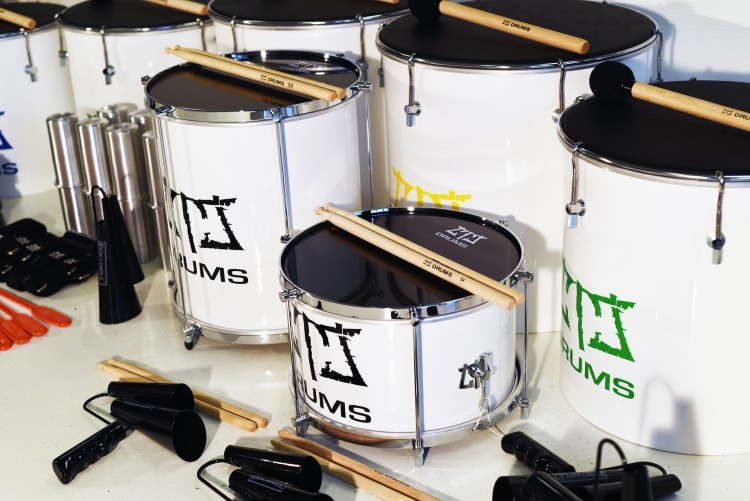Samba Drumming
Posted in Learn | Last Updated on October 4, 2018

We've all seen the YouTube videos of some North-American trying to teach us samba drumming on the drumset. While I don't claim to be an expert in the field, I know that this is not the way to learn about samba.
Samba is one of the hardest feels to replicate for pretty much any drummer, not from Brazil. On paper, it just looks like a bunch of sixteenth notes, with some bass accents and some higher snare accents. The truth is, the Brazilian sixteenth notes are not felt in nearly the same way as we would feel them in our respective countries. They are incredibly unique, very difficult to master, and oh so grooving.
That being said, I'm going to do my best as a non-Brazilian to point you in the right direction when it comes to playing authentic Samba on the drumset.
Authentic Feel
Without getting into the details of its deepest origins, samba is a style of music and dance originating mainly out of Rio De Janeiro in Brazil. Samba dance and samba drumming usually go hand in hand down there, as many samba schools spend the year preparing their show (musical and otherwise) for the Carnaval parade in February.
One of the most important things I feel you need to understand as a drummer is that this music is not meant to be played on a drumset. There can be thousands of drummers in one samba school, each playing one of a handful of traditional percussion instruments. There can be hundreds of people just playing a bass drum part.
I get goosebump every time I hear a real, Brazilian samba school playing at full blast in perfect sync. There's something so moving about that many people playing such a grooving rhythm together
Another important thing to remember is that special feel that I mentioned earlier. The groove is usually felt in cut time, which for our purposes will be 2/4. I'll try my best to explain the unique feel in writing...
Typical western music has even subdivisions. All of our 8th notes, 16th notes, quarter notes, half notes, etc. are always evenly spaced from each other. Everything is very rigid, technically speaking. In Brazilian music, however, there was not much emphasis put on notation, standardization, or quantization, so a very unique way of feeling sixteenth notes developed. The first and last sixteenth notes are felt pretty much the same way we would feel them anywhere else. The real magic is happening on the 2nd and 3rd sixteenth note.
Samba Feel
A visual representation of the 16th note feel used in samba drumming
The 2nd and 3rd sixteenth notes are basically squished together a little bit. They happen a bit faster than the first and last 16th. The feel varies from place to place in Brazil, but that is the general concept. Some places exaggerate it more than others.
The Percussion Parts
There are several individual percussion parts that make up the whole of samba drumming. They each play a key part of the over all samba rhythm. I won't name all the instruments, just the main parts.
- The bass drum (known as the "Surdo") is played using just one stick (held in the strong hand). With that stick, a muted tone is played on beat one, and an open tone on beat 2. The last 16th note of beat 1 is played with the bare left hand, and the hand is removed quickly to let the drum ring. The last sixteenth note of beat 2 is played with the bare left hand as well, but the hand remains on the drum to play the muted stroke.
- The Surdo, or bass drum part of the samba groove.
- The Pandeiro, which is like a tambourine, is playing a stream of those lilted 16th notes I described earlier. The "tamborim" (hand held, jingle-less tambourine played with a stick) also plays this rhythm.
Then we have the samba "clave", which is basically a string of dotted 8th notes that flows over 2 bars starting on the "and" of 1 in bar 2.
Samba Clave
The rhythmic "clave", or "key" to the samba groove.
There are many more subtle parts, and several variations on the parts that I've mentioned, but for the purposes of translating the groove to the drum kit, these are the main parts you need to know/ focus on.
Playing It On The Drum Kit
There is no right way to go about samba drumming. There are hundreds, if not thousands of different ways to translate the traditional samba rhythms to the North American drum set.
The key is to try and simulate the different parts of the samba ensemble using your different limbs and instruments. Here's one way to do it, Feel free to come up with your own.

The "X" on the bass drum line represents a muted stroke. To achieve this, you can bury the beater into the drum head. The notes in brackets are ghost notes and should be softer than the other notes.
The top line is a mixture of the pandeiro/tamborim rhythm, and the samba clave. The challenge is keeping the lilted 16th note feel while playing the clave accents! Play it on the hi-hat or snare drum.
Listen And Experiment
There are so many ways to achieve this authentic samba sound on your drumset. Try to listen to real samba music from Brazil, and see if you can come up with your own spin on samba drumming. Remember to respect the authentic rhythms and parts of the real samba schools.









